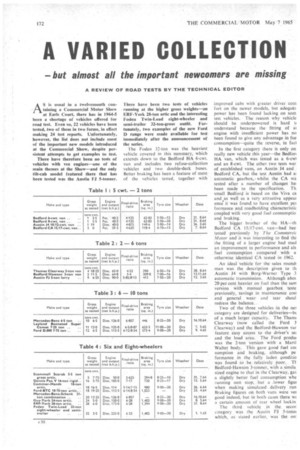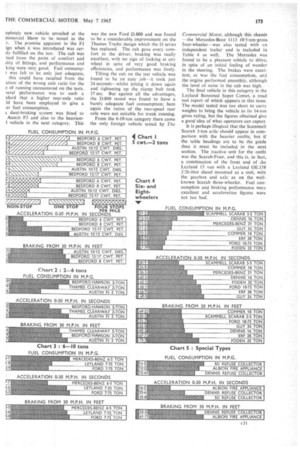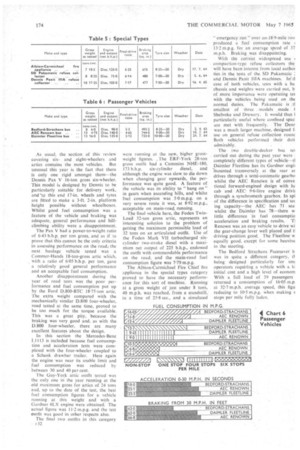A VARIED COLLECTION
Page 174

Page 175

Page 176

If you've noticed an error in this article please click here to report it so we can fix it.
but almost all the important newcomers are missing
A REVIEW OF ROAD TESTS BY THE TECHNICAL EDITOR
As is usual in a twelvemonth containing a Commercial Motor Show at Earls Court, there has in 1964-5 been a shortage of vehicles offered for road test. Even so, 22 vehicles have been tested, two of them in two forms, in effect making 24 test reports. Unfortunately, however, the list does not include most of the important new models introduced at the Commercial Show, despite persistent attempts to get examples to test.
There have therefore been no tests of vehicles with vee engines-one of the main themes at the Show-and the only tilt-cab model featured there that has been tested was the Austin ET 5-tonner.
There have been two tests of vehicles running at the higher gross weights-an ERF-York 28-ton artie and the interesting Foden Twin-Load eight-wheeler and semi-trailer 32-ton-gross outfit. Fortunately, two examples of the new Ford D range were made available for test immediately after the announcement of the series.
The Foden 32-ton was the heaviest vehicle covered in this summary, which extends down to the Bedford HA 6-cwt. van and includes two refuse-collection vehicles and two double-deck buses. Better braking has been a feature of most of the vehicles tested, together with
improved cabs with greater driver corn fort on the newer models, but adequat. power has been found lacking on som, test vehicles. The reason why vehicle should be underpowered is hard t, understand because the fitting of ai engine with insufficient power has no been found to give any advantage in fue consumption-quite the reverse, in fact
In the first category there is only onreally new vehicle this year-the Bedfori HA van, which was tested as a 6-eV and an 8-cwt. The other two tests wer of established vans, an Austin J4 and . Bedford CA, but the test Austin had ai automatic gearbox, -whilst the CA wa tested after a number of changes ha, been made to the specification. Th small Bedford is based on the Viva ca and as well as a very attractive appeal ance it was found to have excellent per formance and roadholding characteristic coupled with very good fuel consumptio and braking.
The bigger brother of the HA-th Bedford CA 15/17-cwt. van-had bee tested previously by The Commerch Motor and it was interesting to find the the fitting of a larger engine had mad an improvement in performance and ads fuel consumption compared with a otherwise identical CA tested in 1962.
An ideal vehicle for the sales round man was the description given to th Austin J4 with Borg-Warner Type 3 automatic transmission. Although abot 20 per cent heavier on fuel than the sarn version with manual gearbox leste previously, savings in maintenance cost and general wearand tear shall' redress the balance..
Two of the three vehicles in the no category are designed for deliveries-bi of a much larger capacity. The Thamf Clearway (now called the Ford P
• Clearway) and the Bedford-Hawson var feature easy access to -the driver's set and the load area. The Ford prodth was the 2-ton Version. with a Marti Walter body. This gave good fuel cot sumption and braking, although pe formance in the 'fully laden conditio was found to be relatively poor. TIBedford-Hawson 3-tonner, with a simila sized engine to that in the Clearway, gas; a slightly better fuel consumption whe running non stop, but a ,lower figui when making simulated delivery run Braking figures on both vans were vet good indeed, but in -both cases there WE a certain amount of rear wheel lockin.
The third vehicle . in the secon category was the Austin FJ 5-tonm which, as stated earlier, was the onl
npletely new vehicle unveiled at the mmercial Show to be tested in the .r. The promise apparent in the FJ ign when it was introduced was cerlly fulfilled on the test. The cab was ised from the point of comfort and ility of fittings, and performance and king were very good. Fuel consump
I was felt to be only just adequate, this could have resulted from the :ction of the wrong axle ratio for the e of running encountered on the tests. ieral performance was to such a idard that a higher rear-axle ratio Id have been employed to give a .er fuel consumption.
dual-braking system was fitted to Austin FJ and also to the heaviest
J vehicle in the next category. This was the new Ford D.800 and was found to be a considerable improvement on the Thames Trader design which the D series has replaced. The cab gave every comfort to the driver, braking was really excellent, with no sign of locking at any wheel in spite of very good braking efficiencies, and performance was lively.
Tilting the cab on the test vehicle was found to be an easy job—it took just 24 seconds—whilst letting it down again and tightening up the clamp bolt took 37 sec. But against all the advantages, the D.800 tested was found to have a barely adequate fuel consumption; here again the ratios of the two-speed rear axle were not suitable for trunk running.
From the 6-10-ton category there came the only foreign vehicle tested by The Commercial Motor, although this chassis —the Mercedes-Benz 1113 10:5-ton-gross four-wheeler—was also tested with an independent trailer and is included in Table 4 as well. The Mercedes was found to be a pleasant vehicle to drive, in spite of an initial feeling of wander in the steering. The brakes were excellent, as was the fuel consumption, and the engine performed smoothly, although the level of noise in the cab was high.
The final vehicle in this category is the Leyland Bonneted Super Comet, a road test report of which appears in this issue. The model tested was too short to carry weights to bring the vehicle to its 14-ton gross rating, but the figures obtained give a good idea of what operators can expect.
It is perhaps illogical that the Scammell Scarab 3-ton artic should appear in comparison with the heavier outfits, but if the table headings are to be the 'guide then it must be included in the next section. The tractive unit for the outfit was the Scarab-Four, and this is, in fact, a combination of the front end of the Leyland 15 van with a Leyland 0E.138 2-26-litre diesel mounted as a unit, with the gearbox and axle as on the wellknown Scarab three-wheeler. Fuel consumption and braking performance were excellent and acceleration figures were not too bad.
As usual, the section of this review covering sixand eight-wheelers and
artics contains the most vehicles. But unusual this year is the fact that there is only one rigid amongst them—the Dennis Pax V 16-ton gross six-wheeler. This Model is designed by Dennis to be particularly suitable for delivery work, and tto this end 17-in, wheels and tyres are fitted to make a 3-ft. 2-in, platform height possible without wheelboxes. Whilst good fuel consumption was a feature of the vehicle and braking was adequate, general performance and hillclimbing ability were a disappointment.
The Pax V had a power-to-weight ratio of 6-43 b.h.p. per ton gross, and as if to prove that this cannot be the only criteria in assessing performance on the road,r the next haulage vehicle tested was a Commer-Hands 18-ton-gross artic which, with a ratio of 6-05 b.h.p. per ton, gave a relatively good general performance and an acceptable fuel consumption.
Another disappointment during the year of road tests was the poor performance and fuel consumption put up by the Ford D.800-BTC 18-75-ton artic. The extra weight compared with the mechanically similar D.800 four-wheeler, road tested at the same time, proved to be too much for the torque available. This was a great pity, because the braking was very good and, as with the D.800 four-wheeler, there are many excellent features about the design.
In this section the Mercedes-Benz L1113 is included because fuel consumption and acceleration tests were completed with the four-wheeler coupled to a Schenk drawbar trailer. Here again the engine was near its usable limit and fuel consumption was reduced by between 30 and 40 per cent.
The Guy-York attic outfit tested was the only one in the year running at the old maximum gross for artics of 24 tons and, up to the date of the test, the best fuel consumption figures for a vehicle running at this weight and with a Gardner 6LX engine were obtained. The actual figure was 11-2 m.p.g. and the test outfit was good in other respects also.
The final two outfits in this category • r32 were running at the new, higher grossweight figures. The ERE-York 28-ton gross outfit had a Cummins NHE-180,
173 b.h.p. six-cylinder diesel, and although the engine was slow to die down when changing gear upwards, the performance was quite good. A feature of the vehicle was its ability to "hang on" in gears when ascending hills, and whilst fuel consumption was 5-0 m.p.g. on a very severe route it was, at 8-92 m.p.g., acceptable on main-road, running.
The final vehicle here, the Foden TwinLoad 32-ton gross artic, represents an interesting solution to the problem of getting the maximum permissible load of 32 tons on an articulated outfit. Use of the Foden Mark VII turbocharged sixcylinder two-stroke diesel with a maxireturn net output of 225 b.h.p., endowed the outfit with commendable performance on the road, and the main-road fuel consumption figure was 7279 m.p.g.
The Albion-Carmichael Fire Chief fire appliance in the special types category proved to have the necessary performance for this sort of machine. Running at a gross weight of just under 8 tons, 40 m.p.h. was reached, from a standstill, in a time of 25.8 sec., and a simulated emergency run " over art\18-9-mile rod produced a fuel consumption rate 13-2 m.p.g. for an average speed of 37 m.p.h. Braking was disappointing.
With the current widespread use 1 compaction-type refuse collectors the will have been interest from local author ties in the tests of the SD Pakamatic and Dennis Paxit 111A machines. In' El ease of both vehicles, tests with a ba chassis and weights were carried out, b of more importance were operating tel with the vehicles being used on the normal duties. The Pakamatic is tl smallest of three models ,made 1 Shelvoke and Drewery. It would thus I particularly useful where confined spac are met with frequently. The Denr was a much larger machine, designed f use on general refuse collection rounc Both vehicles performed their duti admirably.
The two double-decker bus tel carried out during the past year were completely different types of vehicle—t1 Daimler Fleetline has its Gardner engii irnounted transversely• at the rear at drives through a:semi-automatic gea rho whilst the AEC Renown is of conve tional forward-engined design with lu cab and AEC 9-6-litre engine drivii through a synchromesh gearbox. In Spi of the difference in specification and set ing capacity—the AEC has 71 sea whilst the Daimler has 78—there w little difference in fuel consurnptic acceleration and braking results.. Ti Renown was an easy vehicle to drive wi the gear-change lever well placed and ti driving position good. The Fleetline w equally good, except for some heavine in the steering.
The Bedford Strachans Pacesaver b was in quite a different category, tl being designed particularly for smi operators requiring a vehicle with a lc initial cost and a high level of econorn With a full load of 39 passengers returned a consumption of 16-05 m.p at 32.7 m.p.h. average speed, this figu reducing to 10.5 m.p.g. when snaking s stops per mile fully laden.
























































































































































































































































